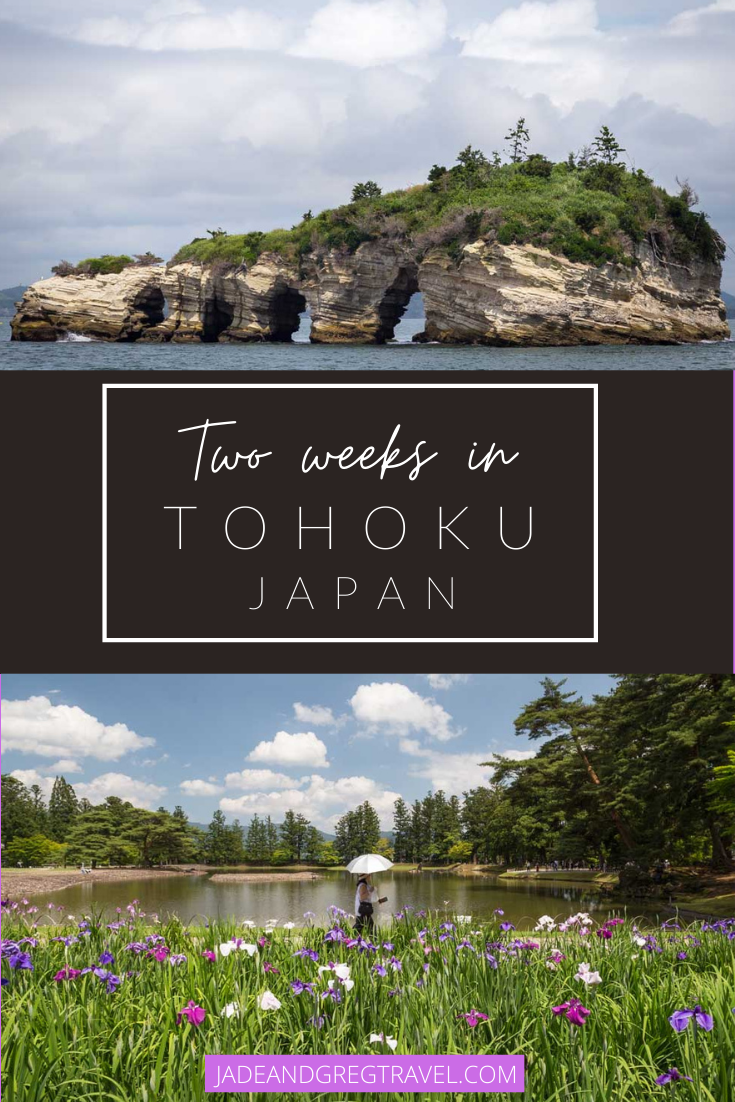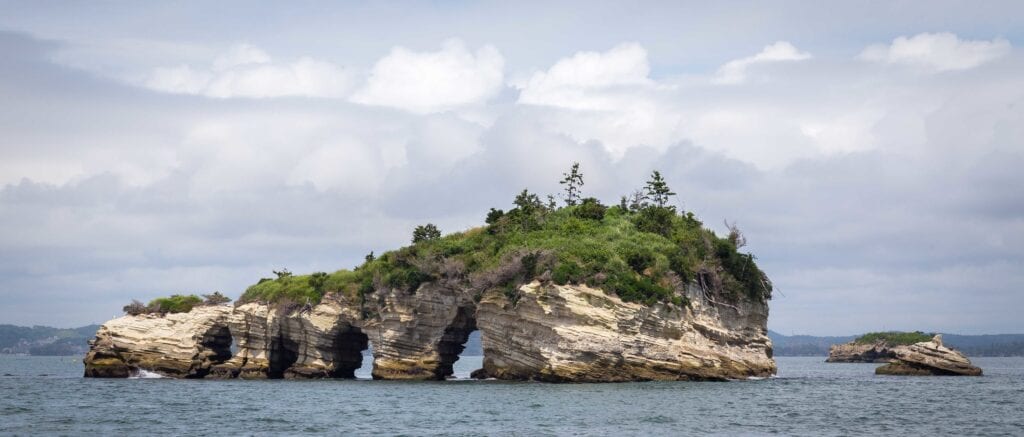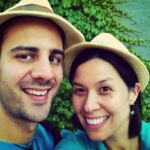
The Tohoku region is the northern part of the main island (Honshu) of Japan and is our favourite part of the country to travel, not least because it attracts very few tourists. It’s also steeped in history, rich in nature, and offers plenty of cultural and culinary highlights. You could easily spend a month travelling just around this part of the country.
It also holds a special place in my heart after living here for a year from 1997-1998. I’ve come back several times over the years to visit friends and introduce Jade to my favourite spo
This time I visited three of the six prefectures that make up Tohoku: Yamagata, Iwate, and Miyagi and I’m going to show you the best places to visit and things to do in each. We had planned to go to the rest together in 2020, but coronavirus scuppered that! We promise to get there soon
Getting There and Around
Sendai City, in Miyagi Prefecture, is the best waypoint for travelling further into Tohoku. It’s a short Shinkansen (Bullet Train) ride from Tokyo. From Sendai, use a JR Tohoku pass to explore the North, or hire a car: the driving is relaxed and convenient. You can also catch a train from Sapporo, if you happen to be starting in Hokkaido.
Table of Contents
Miyagi Prefecture
Sendai
The capital of the Tohoku region and a thriving city of bars, shopping, museums, and just about anything else you could ask for. Travelling solo, I decided to stay low key and social in the immaculate and extraordinarily friendly Hostel Kiko (dorm rooms only).
Sendai is a great place to hang out for a couple of nights before you launch into the far provinces of the North. While you’re here, make sure you:
1. Walk out of the city and up to the ruins of Aoba Castle. The remains of the castle itself amount to a few bricks, but the walk and the view of the city is wonderful.
2. Revere the famous warlord and original King of the North, Masamune Date, who ruled Tohoku from mid 16th to 17th century. You’ll find a statue of him atop his horse near Aoba Castle, and an extravagant stained-glass monument in the main train station.
3. Eat gyu-tan, thick-cut charcoal-grilled beef tongue. Forget the thin slivers you’ll find elsewhere, Sendai gyu-tan is famous for good reason.
4. Eat zunda, a green sticky sweet made from crushed edamame beans. You’ll find zunda mochi, zunda ice cream, zunda cakes…you get the idea.
5. Go out for a night on kokubuncho, the centre of Sendai nightlife.
6. Buy your copy of haiku poet Basho’s Narrow Road to Far Provinces (oku no hosomichi) about his monumental 16th century pilgrimage on foot around Tohoku. This is his most famous work and the simple tales and evocative poems about his journey make the perfect companion as you trace his steps. Look for Basho references on stone markers all around the provinces.
Matsushima
A day trip by train from Sendai, the pine-topped islets of Matsushima Bay is considered one of the greatest views in Japan and have inspired countless woodcuts, paintings, and poems. A haiku attributed to a mind-blown Basho simply states: “Matsushima, ah Matsushima, Matsushima”. Getting here on a cheap local JR train only takes an hour or so. Once you’ve arrived pick up a ticket for a cruise around the islands, then spend the rest of the day wandering around the bay and neighbouring temples and gardens. It has been amply touristified so you don’t need to worry about losing your way: it’s all very close and well-signposted. It’s also a great place to eat seafood, especially the giant scallops you will see grilling along the seafront.
Akiu Falls and hot springs
Akiu waterfall is a worthwhile overnight (or even day) trip from Sendai. It’s 2 hours by train but less than an hour drive. The waterfall and small walk is pretty, especially in Autumn, and it’s one of the few places you can try onsen (hot springs) in this part of the country.
Yamagata Prefecture
Yamagata is a great destination for rugged mountain vistas, lush forests, and skiing. If you’re a hiker it might be worth staying longer. I was here for 3 days and could easily have spent more. But I could say that about pretty much anywhere in Japan.
Here are my top spots:
The official name of Yamadera is Risshaku-ji, but no one ever calls it that. Yamadera translates as ‘Mountain Temple, which is a pretty good description. It is one of my favourite temples in Japan: ancient buildings nestled in thick forest, winding its way up a steep mountain side littered with moss-covered statuettes. In Autumn the view is fiery orange, but I visited on a wet and humid summer day, the rain meant the place was almost deserted and created a hidden, mysterious atmosphere. Basho visited (“in profound silence/the shrill of cicadas/seeps into the rock”) and a statue near the main temple building marks this event, as does a small Yamadera Basho Museum back down the hill. You can get here by train from Sendai (1.5 hours) or car. I stayed in the super quirky and wonderful GLAMPiC Guesthouse, which has its own bar and restaurant.
Dewa Sanzan mountain hikes
The three holy mountains of Dewa Sanzan include Haguro-san, Gas-san, and Yudono-san, representing birth, death, and rebirth respectively. They provide an opportunity for the casual walker to enjoy a relaxing wander through nature or a serious hiker to tackle all three in a long and tiring day. Be aware that they are in different locations so any approach needs to be planned ahead.
I enjoyed my 90 minute walk up to Haguro shrine and down the endless staircase (most people do it the opposite way, but either/or) and found the whole thing very picturesque. There’s a little restaurant half way up the stairs which serves soup made from locally plucked bamboo shoots and, rather quaintly, provides a certificate of fortitude to anyone who makes it thus far.
I attempted Gas-san as well, but even in June it was still snow-covered and I gave up any thoughts of walking at the top of the chairlift. It is a ski field though, and few late season snowboarders were out and about.
Yudono-san is the holiest and apparently most picturesque. It’s closed in winter but otherwise easily accessible from the car park, or more traditionally on the descent from Gas-san.
Yamagata Zao hotsprings and ski resort
I love Zao Onsen. In winter it is a premier ski resort. In summer it’s perfect for a bit of walking and views of the deep blue volcanic lake known as Okama (the name of a traditional Japanese pot, and – coincidentally – a synonym for transexual). All year round it is my favourite hot springs village in Tohoku. The ryokan (traditional Japanese inns/bathhouses) are an amazing and wholly Japanese experience, and the water is hot and therapeutic. I have brought or sent numerous Gaijin friends here over the years and no one has been disappointed. You can check into your ryokan, don a yukata (casual kimono), and wander down the (literally) steaming streets. Be warned however, these are sulphurous waters with a strong smell that will pervade your entire being. But that’s the best bit – an experience you’ll never forget.
Iwate Prefecture
Hiraizumi
This small village in Southern Iwate punches well above its weight in cultural destinations (UNESCO agree). Accessible by car, bus, or train from Sendai, I definitely recommend making a stop here at any time of the year, but especially in June. The main sites are all a short walk from the station.
- Motsuji temple is famous for its Pure Land Garden from the Heian Period, but arrive in June and you will get a special treat as its iris garden comes alive with purples and yellows. This is not to be missed!
- Chusonji temple is set in a pine forest and has a renowned golden hall, Konjikido, dedicated to the Buddha Amida Nyorai.
- You can also take a 90 minute cruise around Geibikei Gorge, though transport for this leaves from Ichinoseki Station, a short ride south of Hiraizumi.
Tono Village
While rarely visited by foreign tourists, the little village of Tono holds a special place in the hearts of Tohokuans (not a word) due to its folklore, compiled into a famous book, Tono no Monogatari (Tales of Tono). The stories of mischievous mythical creatures and the misadventures of local unfortunates have entertained generations and are infused into the spirit of the town. You can get acquainted at the Folktale Museum of Tono around the corner from the station before venturing further afield. Hire an electric bike at the tourist office opposite the station for convenient travel to other attractions. Tono is accessible by train from Sendai (2.5 hours). I stayed in the wonderful Kuranoya Guesthouse, which provided excellent dinners and breakfasts. The very kind owner provided transport to and from the station as well.
Here are my Tono Top Tips:
- Start at the modern and well-curated Folktale Museum to get a taste of Tono Monogatari
- Visit Kappa-buchi, a tranquil stream and pond where the naughty kappa are said to reside. Kappa are green frog-like imps that delight in causing problems for innocent human beings. The saucer of water on their heads needs to be kept wet at all times or they have to run back to their ponds, and legend has it that if you cross their path you only need to bow deeply: when they bow back their saucers empty and you’ve successfully fooled them into retreating. Take note of the small shrine along the stream with a picture of an elderly man in it. He was famous throughout Japan as a friend of the kappas and I had the good fortune to meet him in 1998, sitting in his favourite place by the pond. It was nice to see that he was well-remembered.
- Visit Tono Furusato Mura, a model village museum showing what life was like in Old Tono.
- On the way stop in at Fukusenji Temple.
I actually started the day with a ride to the village museum – if you do this beware of the route suggested by Google Maps. While I enjoyed cycling through the beautiful forest, I was stopped by a woman at the end of my journey who warned me about bears in the area. I survived. Obvs.
I hope you enjoy your trip around Tohoku. If you’ve been to any of these spots and loved them as much as I did, then share your experiences with us.






